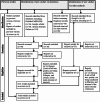Prevalence of interprofessional collaboration towards patient care and associated factors among nurses and physician in Ethiopia, 2024: a systematic review and meta-analysis
- PMID: 40001025
- PMCID: PMC11863922
- DOI: 10.1186/s12912-025-02847-x
Prevalence of interprofessional collaboration towards patient care and associated factors among nurses and physician in Ethiopia, 2024: a systematic review and meta-analysis
Abstract
Introduction: Enhancing clinical outcomes and patient satisfaction can be achieved through interprofessional collaboration between physicians and nurses. Conversely, a lack of nurse-physician interprofessional collaboration compromises patient safety, care, and improvement, and creates moral discomfort for healthcare professionals. Studies indicate that failures in interprofessional collaboration between nurses and physicians lead to adverse medical events, including hospital-acquired infections, medication administration errors, and unnecessary health-related costs.
Objective: This systematic review and meta-analysis aimed to investigate the pooled proportions of the interprofessional collaborations towards patient care and associated factors among nurses and physicians in Ethiopia, 2024.
Methods: A comprehensive search was conducted to find articles on interprofessional collaboration towards patient care and associated factors among nurses and physicians in Ethiopia. The study included cross-sectional studies conducted in Ethiopia and published in English from inception up to August 20, 2024. Excluded were conference proceedings, qualitative research, commentaries, editorial letters, case reports, case series, and monthly and annual police reports. The search encompassed full-text publications written in English and databases such as PubMed/MEDLINE, African Journals Online (AJOL), Semantic Scholar, Google Scholar, and Google. A checklist from the Joanna Briggs Institute (JBI) was used to evaluate the quality of the studies. Two independent reviewers performed data extraction, critical appraisal, and article screening. Statistical analysis was performed using STATA-17 software. A random-effects model was employed to estimate pooled proportions, and effect sizes with 95% confidence intervals were used to analyze determinants of interprofessional collaboration in patient care among nurses and physicians. Funnel plots and Egger's test were used to examine the possibility of publication bias (p-value < 0.10), and the trim-and-fill method by Duval and Tweedie was applied to adjust for publication bias.
Results: Five studies with a total of 1686 study participants that are conducted in three Ethiopian regions and meet the inclusion criteria were reviewed and pooled for this evaluation. The pooled proportions of the interprofessional collaboration towards patient care in Ethiopia is 52.73% (95% CI = 44.66, 60.79%, I2 = 91.5%). Factors such as attitude (favorable attitude towards collaboration) (OR = 1.13, 95% CI: 0.13, 9.89, I2 = 97.7%) and organizational support (satisfaction towards organizational support) (OR = 0.38, 95% CI: 0.07, 2.10, I2 = 97.5%) were not significantly associated with interprofessional collaboration towards patient care.
Conclusion: In summary, this systematic review and meta-analysis reveal that interprofessional collaboration between nurses and physicians in Ethiopia is moderately common, with a pooled proportion of 52.73%. This finding underscores the need for ongoing efforts to enhance collaborative practices to further improve patient care outcomes. Additionally, the review identified two potential contributors to interprofessional collaboration: satisfaction with organizational support and favorable attitudes towards collaboration. However, the pooled effects of these factors did not show a significant association with interprofessional collaboration. This highlights the necessity for further primary research to identify additional factors that may influence interprofessional collaboration and enhance patient care outcomes. Notable limitations of this study include significant variation among studies, a small number of studies, a focus solely on public hospitals, restriction to English-language publications, only observational studies, and limited access to databases such as EMBASE, CINAHL, and Web of Science.
Registration: This systematic review and meta-analysis was registered in Prospero with the registration ID and link as follows: CRD42024579370; https://www.crd.york.ac.uk/prospero/#recordDetails .
Keywords: Collaboration; Ethiopia; Interprofessional; Meta-analysis; Nurses and Physicians; Systematic review.
© 2025. The Author(s).
Conflict of interest statement
Declarations. Ethics approval and consent to participate: Not applicable. Consent for publication: Not applicable. Competing interests: The authors declare no competing interests. Protocol registration: This systematic review and meta-analysis was registered in PROSPERO with the registration ID and link as follows: CRD42024579370; CRD register@york.ac.uk. https://www.york.ac.uk/inst/crd . https://www.crd.york.ac.uk/prospero/#recordDetails .
Figures












Similar articles
-
Prevalence of medication administration errors and its determinants among nurses in Ethiopia: a systematic review and meta-analysis.BMC Nurs. 2025 May 16;24(1):544. doi: 10.1186/s12912-025-03186-7. BMC Nurs. 2025. PMID: 40380296 Free PMC article.
-
Mortality and its determinants among patients attending in emergency departments.BMC Emerg Med. 2024 Jul 19;24(1):125. doi: 10.1186/s12873-024-01050-6. BMC Emerg Med. 2024. PMID: 39026180 Free PMC article.
-
Uptake of evidence-based practice and its predictors among nurses in Ethiopia: a systematic review and meta-analysis.Front Pharmacol. 2024 Jul 18;15:1421690. doi: 10.3389/fphar.2024.1421690. eCollection 2024. Front Pharmacol. 2024. PMID: 39092215 Free PMC article.
-
Patient safety culture in public hospitals of Ethiopia: A systematic review and meta-analysis.PLoS One. 2025 Jun 4;20(6):e0325723. doi: 10.1371/journal.pone.0325723. eCollection 2025. PLoS One. 2025. PMID: 40465761 Free PMC article.
-
Birth preparedness and complication readiness among pregnant women in Ethiopia: a systematic review and Meta-analysis.Reprod Health. 2018 Oct 29;15(1):182. doi: 10.1186/s12978-018-0624-2. Reprod Health. 2018. PMID: 30373598 Free PMC article.
References
-
- 2010. WHOI-pcpI. Inter-professional collaboration practice (IPCP). 2010.
LinkOut - more resources
Full Text Sources

